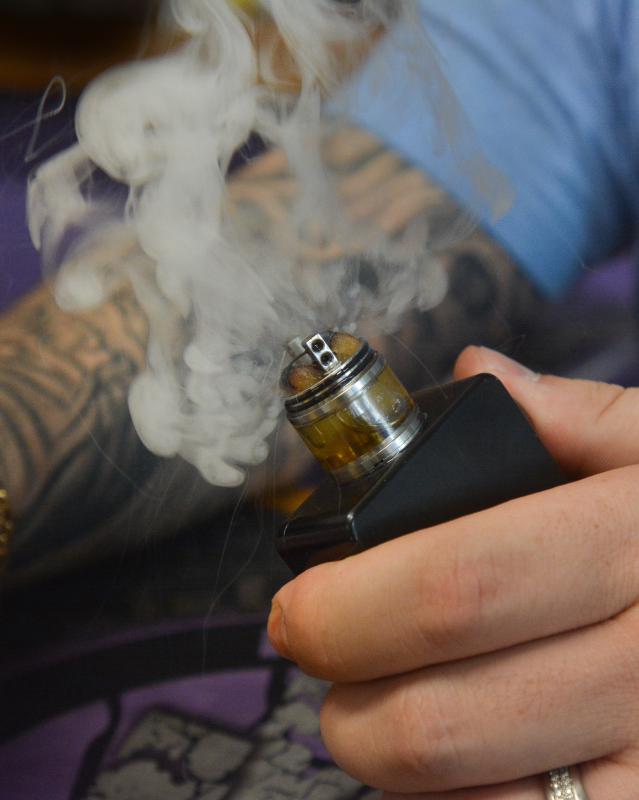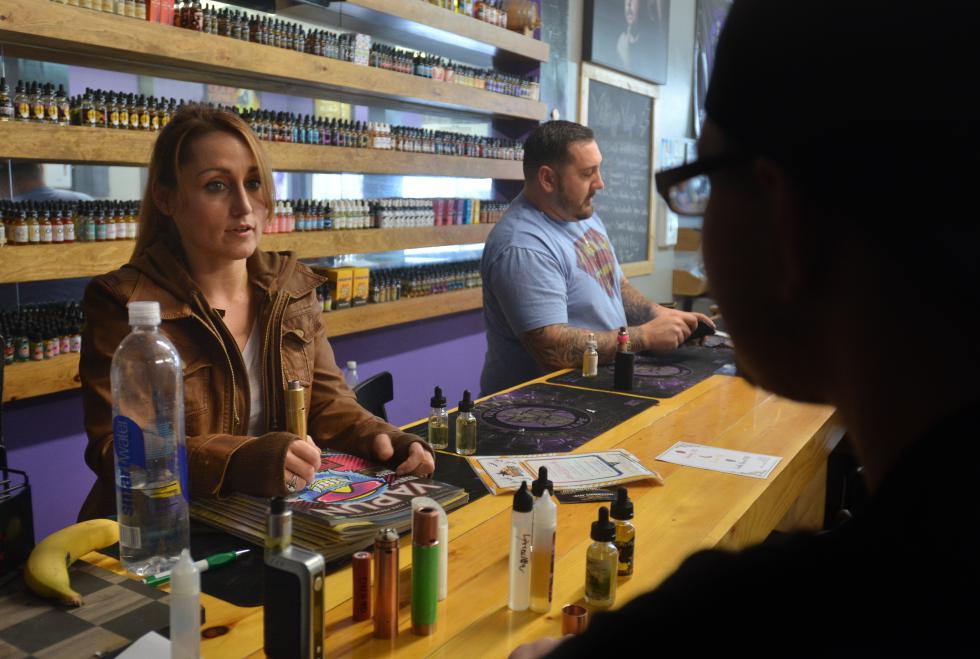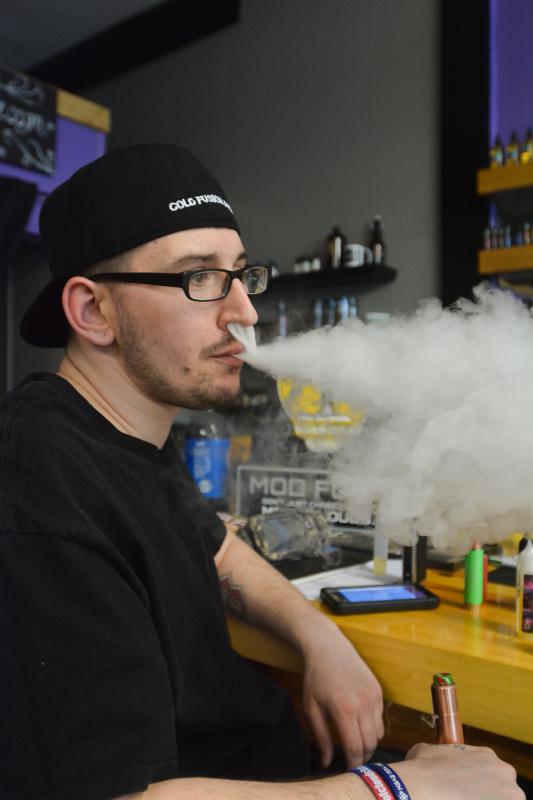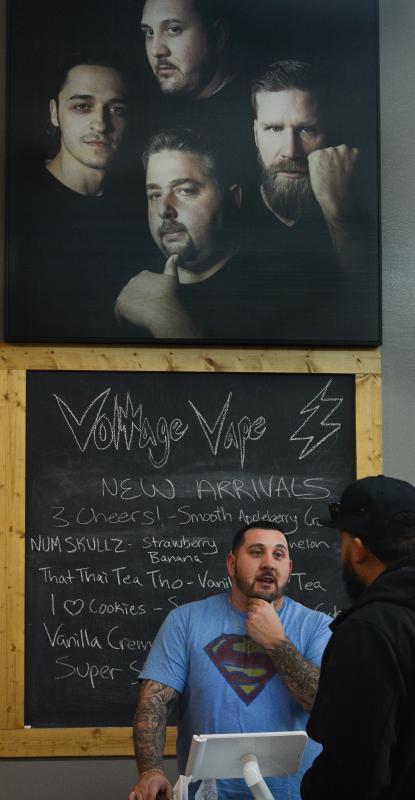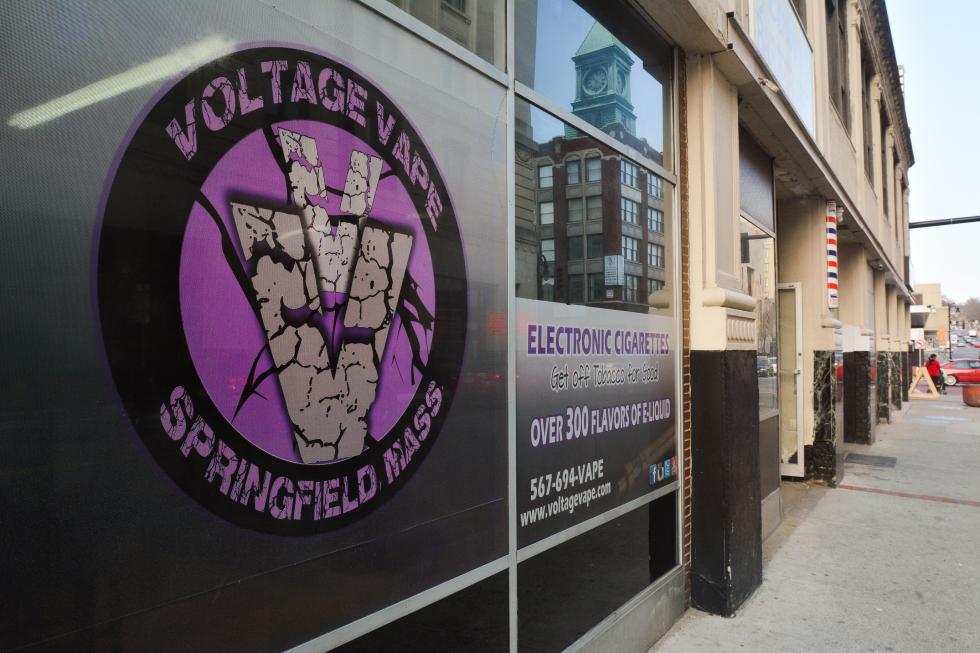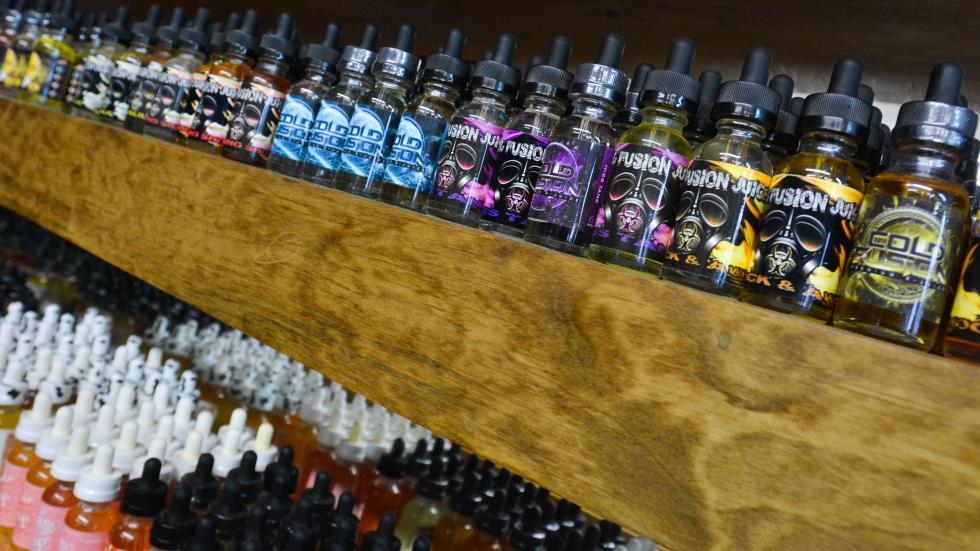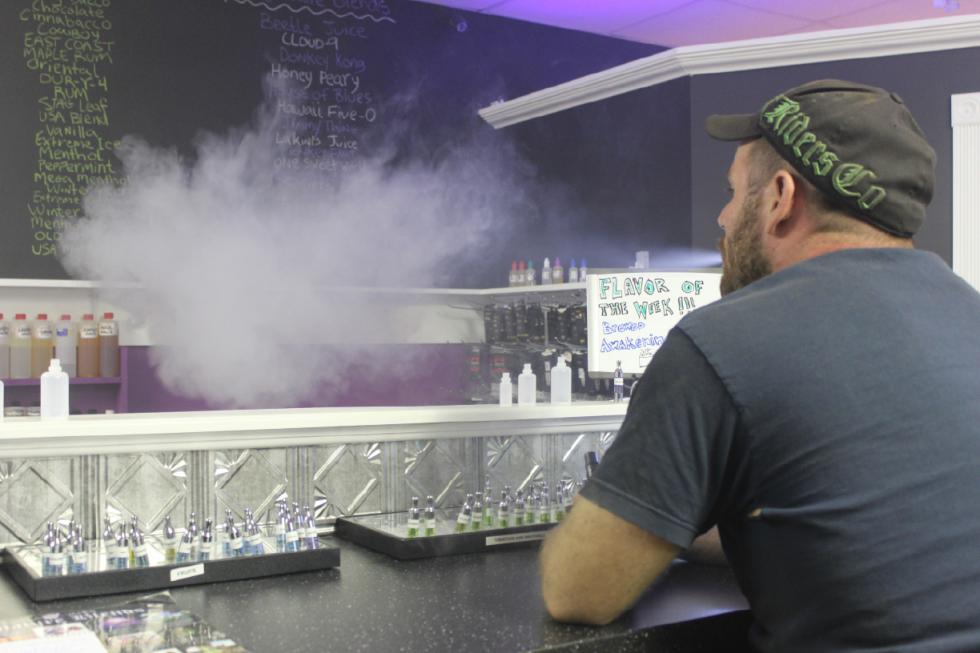Stephen Bilia’s Gorilla Vapess is like a candy shop for adults. Vapers smoke at the bar, ordering from a list of two hundred-plus flavors displayed in multi-colored chalk. Squirt bottles full of food-grade flavor concentrates wait to be ordered and mixed with propylene glycol, vegetable oil, and nicotine.
“We’re closer to candy than tobacco,” Bilia says.
For me it’s a big hand to mouth addiction, says Chris Wetherell, who I find vaping at the bar with Bilia. Wetherell is three months cigarette-free. He says vaping is working for him because it still offers the same sensation as smoking cigarettes, the same “lung hit.” He says he’s down to 1 milligram of nicotine a day, down from two packs of tobacco cigarettes a day.
The flavor of the week, “Brewed Awakening,” tastes like caramel and coffee. Just like at an ice cream shop, staffers dispense samples of the liquids so customers can make more informed purchases. The one-cent samples are given at zero-nicotine, and a pen-shaped mod sits at the counter beside a bin of disposable mouthpieces.
Over the past couple of years, the vaping industry has blown up with shops like Gorilla Vapes on Elm Street in Westfield popping up all across the Valley. Though the products are shaped differently and certain models are more powerful, e-cigarettes and vaping are the same: e-liquids are heated and inhaled. The liquid, now available in thousands of flavor combinations, typically contains propylene glycol, vegetable oil, concentrated flavorings, and varying levels of nicotine. A vaper fills his vape with the juice, which then drips into the vape’s tank, which is connected to an atomizer near the mouthpiece. The atomizer is made up of a wad of cotton and an electrical circuit, which heats the the liquid to 212 degrees, vaporizing it. The hobby, as it’s called, is popular with people who have smoked or would smoke and people who enjoy a sweet taste in their mouths. A Center for Environmental Health report from Sept. 2015 shows U.S. sales at about $3.5 billion a year — the bulk of which is being generated by small to mid-sized start-ups.
While vaping and e-cigarettes are being hailed by some as a healthier alternative to regular smoking tobacco, there are others who say not enough research has been done about the health effects of vaping and there’s some evidence vaping is a gateway to tobacco cigarette smoking for young people.
Adam Guilbert, 20, of Westfield, says vaping at low doses of nicotine means he’s not addicted — if he’s out of town, he says, he won’t vape for a week and it’s “no problem.” He says that working as an electrician exposed him to heavy smokers on construction jobs, and so instead of reaching for cigarettes, he reached for the vape.
Wetherell, 28, of Westfield says he’d be worse off driving behind a diesel truck with the windows down than vaping.
But medical professionals aren’t so laissez-faire.
The scientific community knows only a little about the first-hand effects of vaping and next to nothing about second-hand inhalation of vapors, says pulmonary physician Douglas Johnson of Baystate Medical Center. There’s plenty cause for alarm in the products’ addictive qualities.
“It’s very concerning that there’s this addictive, unregulated substance,” says Johnson. “I think for everyone under age 21, access should be limited.”
Richard Peltier, an assistant professor specializing in aerosols in the department of environmental health sciences at UMass Amherst, says that although it’s hard to debate that vapor products are healthier than cigarettes, some recent studies should have you thinking twice about vaping. He says that while the ingredients can appear benign, there’s much we don’t know about what happens chemically when they’re vaporized and inhaled.
“One [study] looks look at how human lungs are immunosuppressed when exposed to some of these vaping products,” Peltier says. “It’s changing some of the biology of your body — it’s changing your immune system. It’s turning genes on and off.”
Johnson says he’s hesitant to recommend vaping to patients looking to quit smoking.
“For people who have very bad lung function who’ve failed at numerous efforts to quit, these products might expose them to less damaging smoke,” Johnson says. “It’s very rare — it’s much, much better to get them to totally quit.”
Peltier says it will likely be another three to five years before a clear answer to just how healthy or unhealthy these products are emerges. “Companies are far faster and more sophisticated at launching products into the marketplace because they have a financial incentive to do so.”
Gregory Conley, president of the American Vaping Association, says it doesn’t take a lot of study to see that inhaling vapor is better than smoke. He advocates for the government creating regulations for vaping that make sense, but instead the response has been “hysteria.”
As the phenomenon found a home in head shops and new vape stores in the years since 2013, the products went virtually unregulated and its health impacts unmeasured. Now, scientists are starting to see some worrying effects from vapor products in preliminary studies and if a Food and Drug Administration expansion rule passes, it could put vaping and smoking tobacco in the same regulation category.
The regulation submitted by the FDA to the Obama administration’s Office of Management and Budget would extend the agency’s authority to regulate e-cigarettes and vapor products under the tobacco umbrella, though there’s no tobacco in the products. The regulation, if approved, would require thousands of small-batch e-juice makers to apply for FDA approval in a costly process that would require business owners to file a pre-market tobacco application for each product. The FDA has estimated that testing the products and processing the applications could cost a business owner $2 million to $10 million per item.
“It would decimate tens of thousands of small and medium-sized businesses on the market,” Conley says.
But vaping isn’t just getting a challenge at the federal level. States are looking to regulate, too. Conley says Massachusetts is putting up the biggest barriers to vaping in the U.S. Last September, Massachusetts passed new regulations that include requirements for childproof containers and product placement out of arm’s reach in stores. They also set the age restriction for purchasing vapor products at whatever the municipal minimum is for tobacco products, ages 18 and up.
Cheryl Sbarra, senior staff attorney for Massachusetts Association of Health Boards, says she and her colleagues have worked with municipal boards of health in more than 100 communities statewide to prohibit the use of e-cigarettes and vaporizers wherever smoking tobacco is nixed — and she’d like to see that number grow. Sbarra points out that many of the e-juices used by vapers contain nicotine, the same addictive chemical in tobacco cigarettes, and the sweet juices vapers use can be enticing for kids and teens. Vaping is a gateway to cigarettes, she says.
“We’ve seen a huge increase in the number of underage children using these products,” says Sbarra. “Which is also a concern because many of these children report they have not used tobacco products.”
Teens and young adults who had never smoked but used e-cigarettes were 8.3 times more likely to progress to cigarette smoking after one year than nonusers of e-cigarettes, according to the Centers for Disease Control and Prevention’s E-cigarettes: An Emerging Public Health Challenge.
Sbarra says that just because the science hasn’t caught up doesn’t mean they shouldn’t restrict the products in the meantime. “The science frequently follows the policy,” says Sbarra. “We know in our gut it’s really not good to use something that might explode — it’s really not good to be inhaling that stuff and I don’t think you need to be a rocket scientist to figure that out.”
No one at the vape shops was denying that science would discover downsides to their flavored clouds, but vapers were confident those downsides are far fewer than those associated with smoking.
“At the end of the day is it safer to not vape? Absolutely,” says Gorilla Vapes owner Stephen Bilia, who smoked cigarettes for decades before he says vaping helped him quit. “But is it the lesser of two evils? Absolutely. I’ve tried everything and this is what finally did it for me.”•
Contact Amanda Drane at adrane@valleyadvocate.com.

